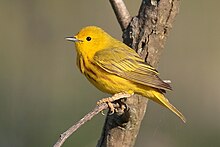Yellow warbler
| Yellow warbler | |
|---|---|
 |
|
| Male in breeding plumage, Canada | |
| Scientific classification | |
| Kingdom: | Animalia |
| Phylum: | Chordata |
| Class: | Aves |
| Order: | Passeriformes |
| Family: | Parulidae |
| Genus: | Setophaga |
| Species: | S. petechia |
| Binomial name | |
|
Setophaga petechia (Linnaeus, 1766) |
|
| Subspecies | |
|
About 35 (but see text) |
|
 |
|
| Distribution of the yellow warbler Breeding range Year-round range Wintering range | |
| Synonyms | |
|
|
About 35 (but see text)
The yellow warbler (Setophaga petechia, formerly Dendroica petechia) is a New World warbler species. Sensu lato, they make up the most widespread species in the diverse Setophaga genus, breeding in almost the whole of North America and down to northern South America.
The genus name Setophaga is from Ancient Greek ses, "moth", and phagos, "eating", and the specific petechia is from Italian petecchia, a small red spot on the skin.
Other than in male breeding plumage and body size, all subspecies are very similar. Winter, female and immature birds all have similarly greenish-yellow uppersides and are a duller yellow below. Young males soon acquire breast and, where appropriate, head coloration. Females are somewhat duller, most notably on the head. In all, the remiges and rectrices are blackish olive with yellow edges, sometimes appearing as an indistinct wing-band on the former. The eyes and the short thin beak are dark, while the feet are lighter or darker olive-buff.
The 35 subspecies of D. petechia sensu lato can be divided into three main groups according to the males' head color in the breeding season. Each of these groups is sometimes considered a separate species, or the aestiva group (yellow warbler) is considered a species different from D. petechia (mangrove warbler, including golden warbler); the latter option is the one currently accepted by the International Ornithological Congress World Bird List.
Depending on subspecies, the American yellow warbler may be between 10–18 cm (3.9–7.1 in) long, with a wingspan from 16 to 22 cm (6.3 to 8.7 in). They weigh 7–25 g (0.25–0.88 oz), varying between subspecies and whether on migration or not, globally averaging about 16 g (0.56 oz) but only 9–10 g (0.32–0.35 oz) in most breeding adults of the United States populations. Among standard measurements throughout the subspecies, the wing chord is 5.5 to 7 cm (2.2 to 2.8 in), the tail is 3.9 to 5.6 cm (1.5 to 2.2 in), the bill is 0.8 to 1.3 cm (0.31 to 0.51 in) and the tarsus is 1.7 to 2.2 cm (0.67 to 0.87 in). The summer males of this species are generally the yellowest "warblers" wherever they occur. They are brilliant yellow below and greenish-golden above. There are usually a few wide, somewhat washed-out rusty-red streaks on the breast and flanks. These markings are scientific namesake of the species since petechia roughly translates to "liver spotted", of which the reddish markings of the male were apparently reminiscent of for ornithologists. The various subspecies in this group mostly in brightness and size as per Bergmann's and Gloger's Rule.
...
Wikipedia

